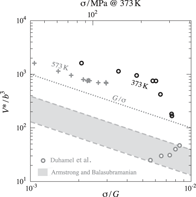No CrossRef data available.
Article contents
In situ study of thermally activated flow and dynamic restoration of ultrafine-grained pure Cu at 373 K
Published online by Cambridge University Press: 18 September 2017
Abstract

Pure Cu was made ultrafine-grained by equal channel angular pressing on route BC at ambient temperatures and deformed in situ in a scanning electron microscope at the elevated temperature of 373 K and at a constant total strain rate of 10−4 s−1. Deformation was repetitively stopped to take micrographs of the grain structure on the same area of observation, revealing limited activity of discontinuous dynamic recrystallization. During the stops of deformation, the flow stress was relaxing. The relaxation of stress as function of time was used to determine the rate of inelastic deformation as a function of stress, from which the activation volume  ${V^ * }$ of the thermally activated flow was derived. It is found that the normalized values of
${V^ * }$ of the thermally activated flow was derived. It is found that the normalized values of  ${V^ * }$ were lying in the same order generally found for coarse-grained pure materials. This seems to be in conflict with the literature. However, the conflict is resolved by noting that the literature results refer to quasistationary deformation with the concurrent dynamic recovery in contrast to the present results obtained at a virtually constant microstructure. The interpretation of the two kinds of activation volumes for thermally activated flow is discussed.
${V^ * }$ were lying in the same order generally found for coarse-grained pure materials. This seems to be in conflict with the literature. However, the conflict is resolved by noting that the literature results refer to quasistationary deformation with the concurrent dynamic recovery in contrast to the present results obtained at a virtually constant microstructure. The interpretation of the two kinds of activation volumes for thermally activated flow is discussed.
- Type
- Articles
- Information
- Journal of Materials Research , Volume 32 , Issue 24: Focus Issue: Mechanical Properties and Microstructure of Advanced Metallic Alloys—in Honor of Prof. Haël Mughrabi PART B , 28 December 2017 , pp. 4514 - 4521
- Copyright
- Copyright © Materials Research Society 2017
Footnotes
Contributing Editor: Mathias Göken
Dedicated to Prof. Hael Mughrabi on the occasion of his 80th birthday.





